Originating in Asia, pheasants are regarded as one of the oldest game birds. They are famous for their beautiful plumage and bright colors, especially the roosters.
One factor that contributes to the overall beauty of pheasants is their diversity. There are approximately 49 species of pheasants in the world and several subspecies. Each subspecies and species bring some uniqueness that adds details to the overall elegance of pheasants.
So, how about getting some exciting info on some of the many pheasants? In this article, we have compiled various details about 21 different types of pheasants. We talk about their origins, color variations, and much more.
Table of Contents
Himalayan Monal
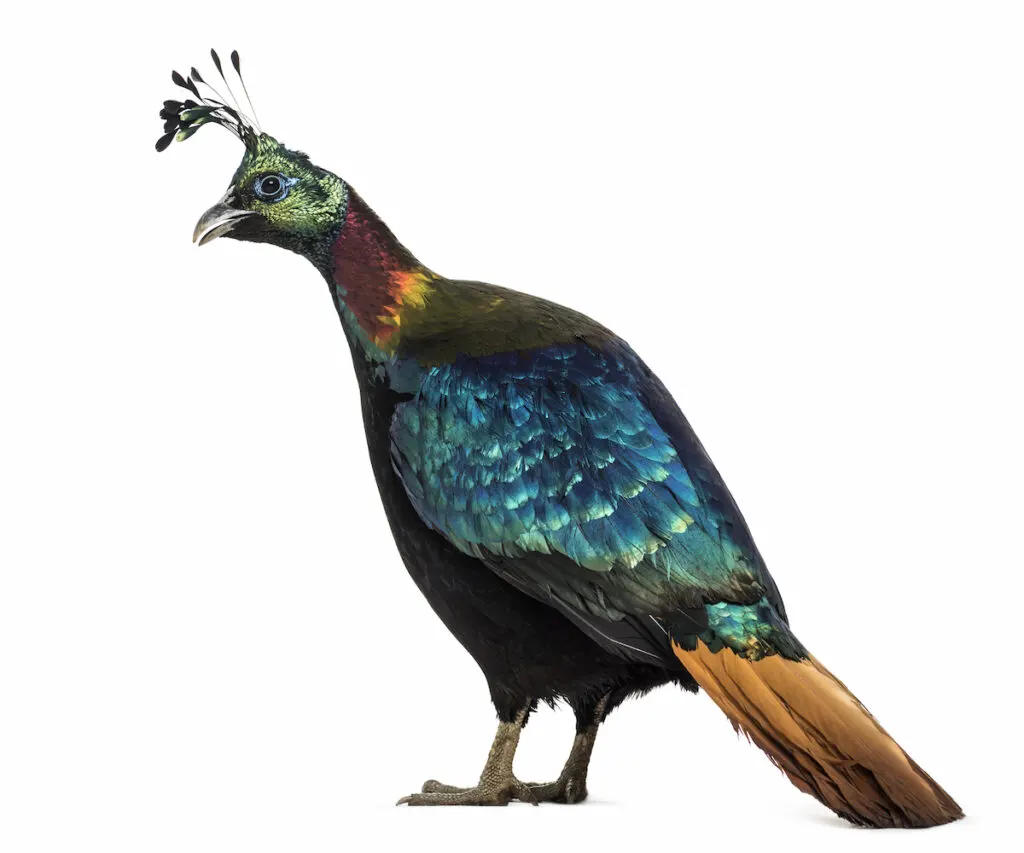
The Himalayan Monal Pheasant, also called the Impeyan Monal or Impeyan Pheasant, is indigenous to western China, the Himalayas, and eastern Afghanistan. You can also find them in Southern Tibet, Bhutan, Nepal, India, and Pakistan.
Himalayan Monal Pheasants prefer to inhabit cool temperate conifer forests interspersed with alpine meadows, grassy slopes, and cliffs at elevations of 9000-10,000 feet.
During summer Himalayan Monal Pheasants can migrate as high as 16,000 feet and as low as 6,500 feet in the winter, in what is called altitudinal migration. They can tolerate snow and will often dig in the snow foraging for food.
Himalayan Monal Pheasants are large birds with an average length of 2.3 feet. Males and females usually weigh an average of 4.4 – 5.2 pounds. The females are lighter and smaller than the male.
Male Himalayan Monal Pheasants have reddish copper on the sides and back of their neck, metallic green crests, and white back & rump during flight. Males also have black underparts and breasts with copper tails. They have a patch of turquoise blue skin around their eyes.
Although female Himalayan Monal Pheasants have dull plumage, they are still attractive birds. They have brownish-black feathers on their upper regions with a short crest and white throats. The lower parts of their tails are white with black bars. They also have a patch of blue skin around their eyes.
Himalayan Monal Pheasants are excellent diggers, and they use their heavy bills to dig up insects and tubers.
Golden Pheasant
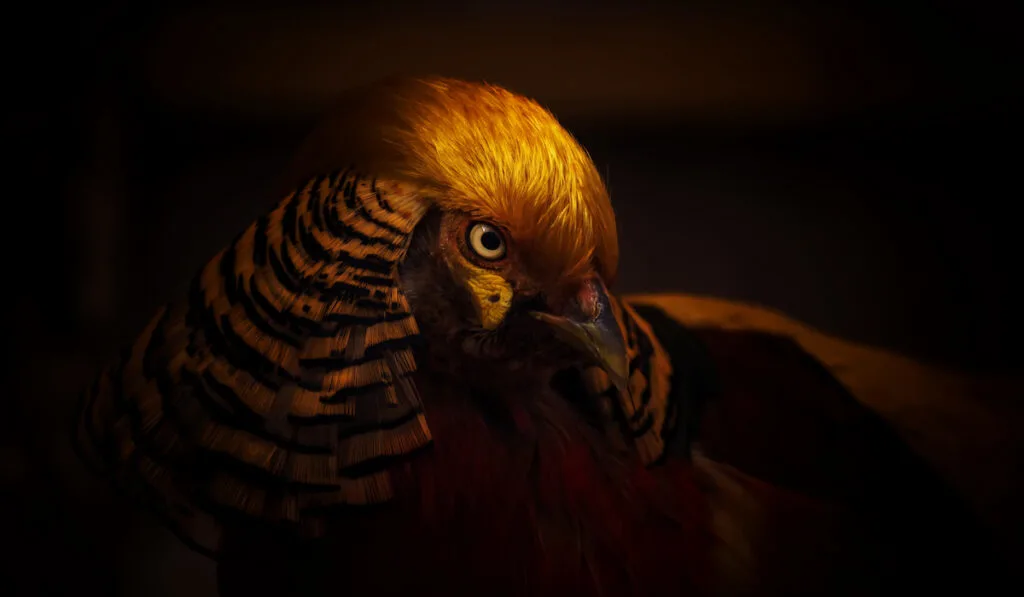
Golden Pheasants are also known as Chinese Pheasants. They are said to be one of the most beautiful birds in the world. These pheasants are indigenous to the forests of central and western China.
The Golden Pheasant is famous for its colorful plumage and is one of only two pheasant species to possess the ruffle feature.
Of the two sexes, the male Golden Pheasant is more colorful with a golden crest tipped with a red outline that flows from their heads down to their necks. The female has a pale brown face, breast, throat, and sides with a mottled brown plumage. It is more slender than the male.
The Golden Pheasant diet consists mainly of seeds, grubs, invertebrates, berries, and other kinds of vegetation.
Common Pheasant
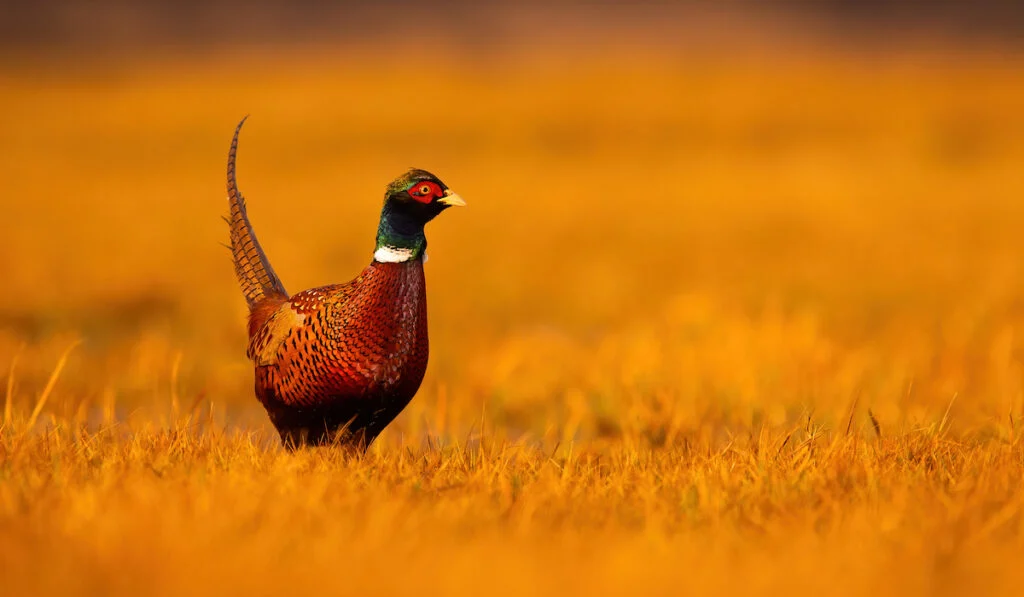
The Common Pheasant, or Ring-Necked Pheasant, is indigenous to Asia. However, it is commonly found in several parts of North America.
Male Ring-Necked Pheasants have a vibrantly colored plumage, green or blue heads, and white neck rings. Female pheasants are usually plain brown and not as colorful as the male. Apart from the colorful variants, Male Ring-Necked Pheasants can also appear all black or all white.
Ring-Necked Pheasants prefer to inhabit farmlands and fields that have enough bushy cover. These pheasants can also inhabit wet marshy lands and woodlands. Common Pheasants tend to stay on the ground to search for food like insects, seeds, grains, small animals, and berries.
Reeves’s Pheasant
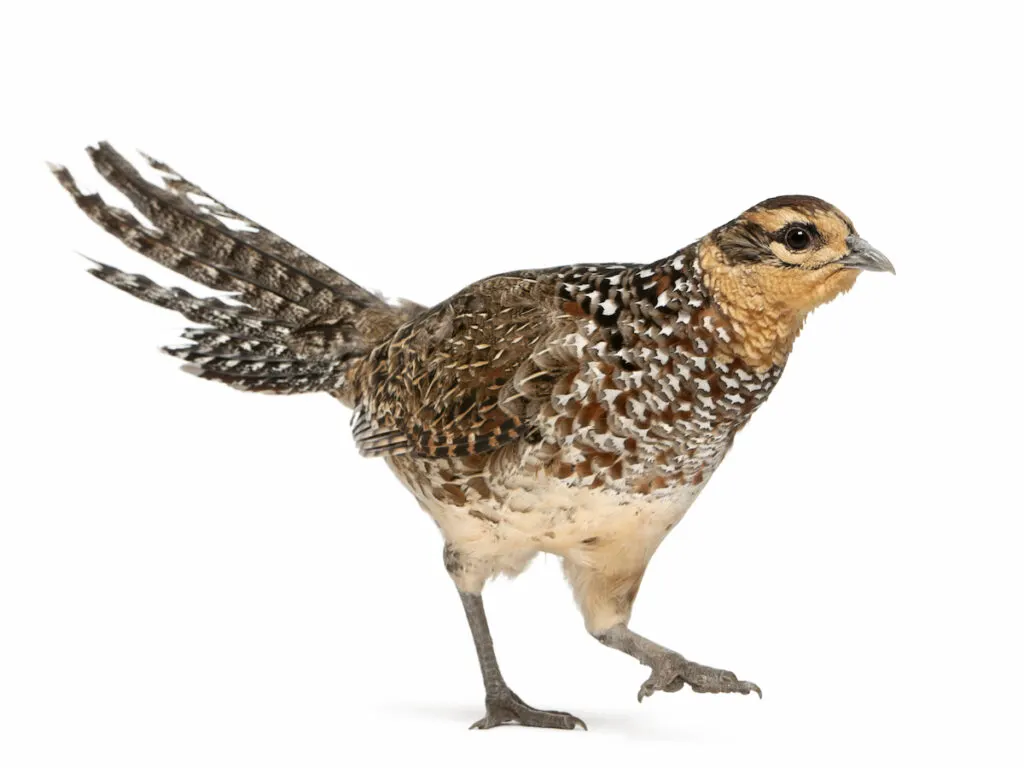
Reeves’s Pheasants are indigenous to Central and Eastern China. You can also find them in France, the Czech Republic, the UK, and the United States. They primarily feed on seeds and vegetables.
One thing that stands out about this bird is its long tail. Reeves’s Pheasants measure about 6.8 feet in length alongside their tail.
Unlike other pheasant breeds, male and female Reeves’s Pheasants have a similar appearance. Reeves’s Pheasants have colorful brown, green, and black patterned feathers. However, the males have a long silver-white tail with brown patterns.
Reeves’s Pheasants can sometimes be aggressive towards animals, humans, and other pheasants.
Mikado Pheasant

The Mikado Pheasant is a beautiful pheasant indigenous to the mountains of Central Taiwan. It is also drawn on the Taiwanese dollar and is unofficially the national bird. Taiwanese often refer to the Mikado Pheasant as the “King of The Mist.”
Male Mikado Pheasants are dark-colored birds that give off shades of purple or blue when exposed to sunlight. And they have red wattles and white striped tails.
Females have olive-brown plumage with a dull red wattle, and both sexes have grey legs.
Mikado Pheasants prefer to inhabit areas with dense shrubs and bamboo growth. They like to forage for seeds, fruit, leaves, vegetation, and invertebrates. And they typically do so on foggy or rainy days.
Elliot’s Pheasants
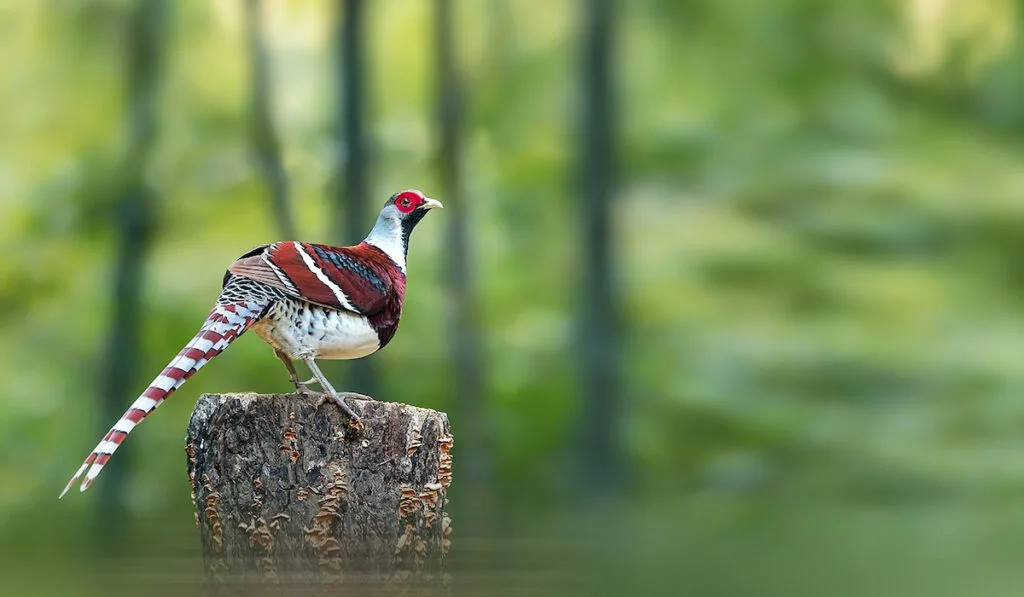
Elliot’s Pheasant is also known as the Bar-Backed Pheasant or Chinese Barred-Backed Pheasant. Elliot’s Pheasants are indigenous to the mountain forests and thick evergreens of southern China. In their natural habitats, Elliot’s Pheasants can live in altitudes as high as 6,200 feet.
Elliot’s Pheasant is a large, beautiful pheasant that can measure up to 31 inches in length. Males have reddish-brown chestnut wings with broad blue-steel bands and chestnut brown crowns. They also have grey legs, horny yellow bills, and brown to orange iris.
Females have rufous brown crowns with blackish tips. They also have grey legs, brown iris, and horny brown bills.
The diet of Elliot’s Pheasant consists mainly of ants, berries, leaves, and seeds.
Blue-Eared Pheasants

The Blue-Eared Pheasants are a monotypic pheasant species commonly found in the mountainous forests of western and central China. Generally, they are well adapted to the high altitudes of these mountainous regions.
Blue-Eared Pheasants are large pheasants, and they can measure up to 3.1 feet in length. One of the distinguishing features of a Blue-Eared Pheasant is its scarlet-red facial skin. Their plumage is usually dark blue-grey with white, extended ear covers and a velvet-black crown.
Both male and female Blue-Eared Pheasants have similar appearances. However, the female is usually smaller than the male. You can distinguish both sexes using their spurs.
Males have round and large spurs, while those of the females are small and oblong-shaped.
Blue-Eared Pheasants are heavy diggers. They till the ground in search of insects, roots, and grubs, and more times than not, they do the digging with their bills instead of their feet. Blue-eared Pheasants also feed on vegetables and berries.
Siamese Firebacks
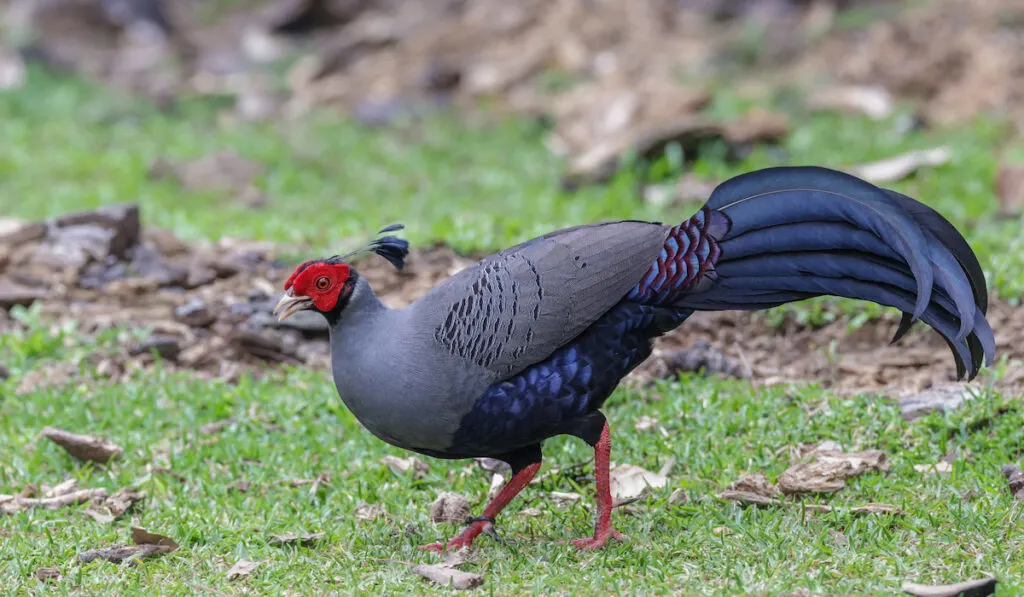
Siamese Fireback or Diard’s Fireback is a pheasant species indigenous to Southeast Asia.
It is commonly found in the forest of Laos, Cambodia, northern Vietnam, and eastern Thailand. Siamese Firebacks tend to inhabit bamboo forest areas, dense-evergreen areas, and semi-evergreen areas.
Siamese Firebacks are medium-sized pheasants that can measure up to 31 inches in length. Male Siamese Firebacks are known for their long crest of purple-black feathers that can measure up to 3.5 inches in length.
The feathers become erect when the bird gets excited. When they are found, male Siamese Firebacks are typically in the company of two to three females.
The facial wattles of the male Siamese Fireback are bright red, while the face behind the wattle, throat, and head is black. They have yellow legs and feet with yellow bills.
Females Siamese Firebacks are not as colorful as the males. However, they are more attractive due to their unique markings. Females have no crest, while their wattles are duller and of smaller sizes than males. They have red feet and legs with dark grey bills.
Vieillot’s Crested Firebacks
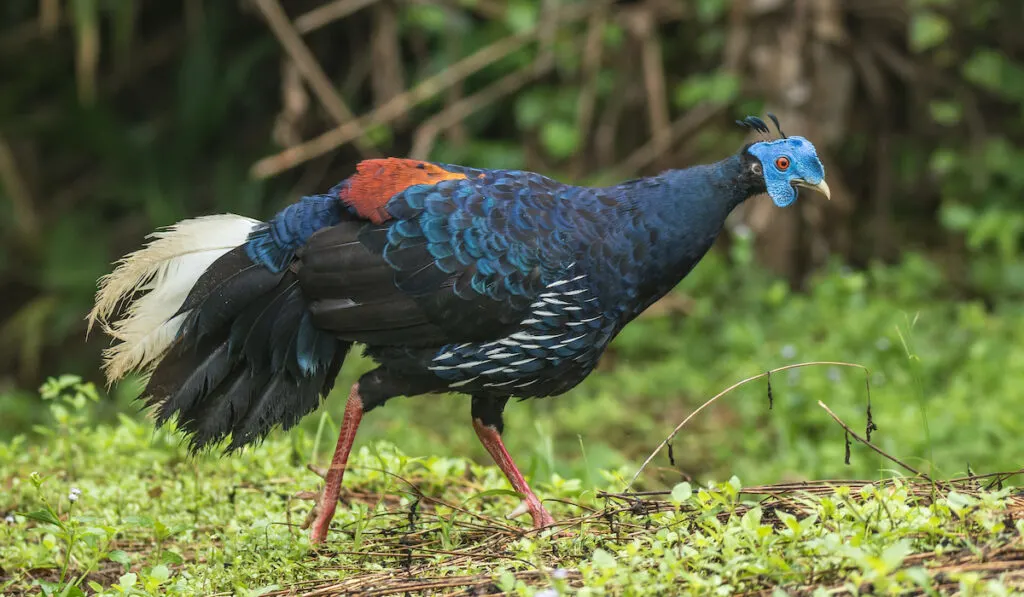
The Vieillot’s Crested Fireback Pheasant, also known as the Malayan Crested Fireback, is a pheasant indigenous to Sumatra and Malaysia.
Male Vieillot’s Crested Firebacks have glossy blue/black plumage. The top half of their tail is pure white, and they have white streaks on the sides of their body. They also have large spurs, blue facial wattles, and bushy crests.
Female Vieillot’s Crested Firebacks may not be as colorful, but they are still quite lovely. Females have a chestnut-brown plumage with a flatter crest and blue facial skin. The breast feathers of the female are edged in white.
Temminck’s Tragopans
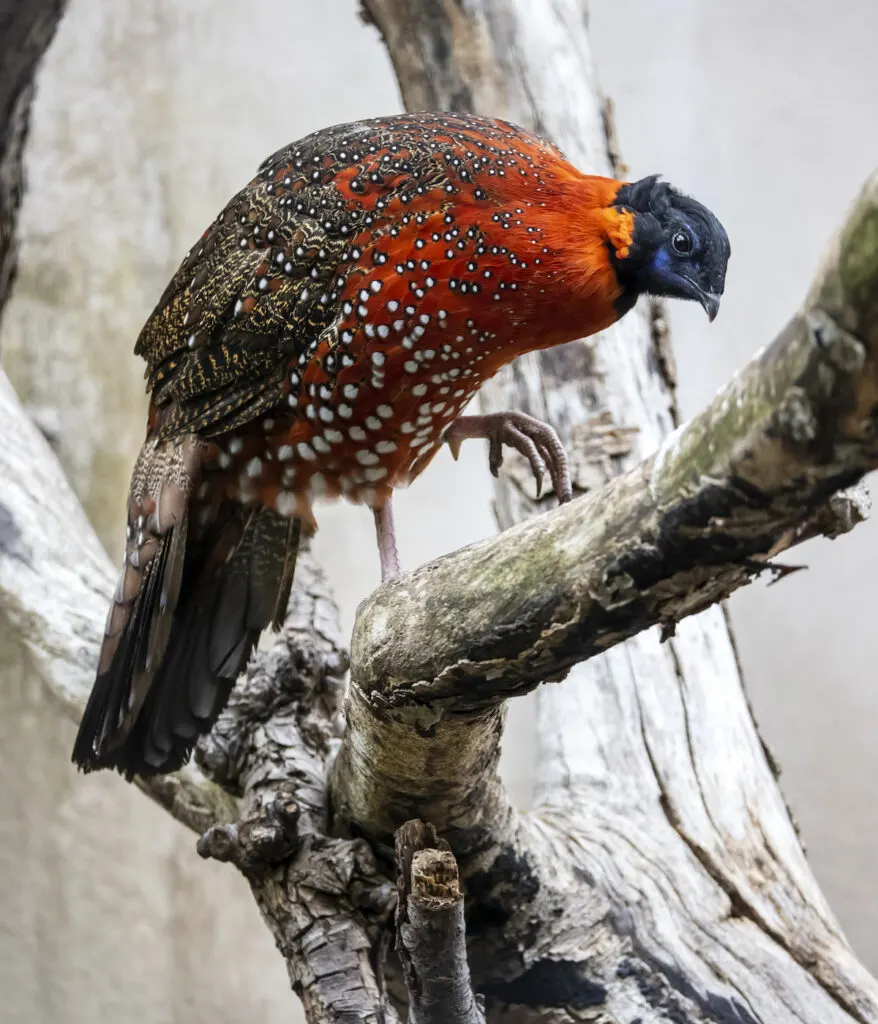
The Temminck’s Tragopan Pheasant is commonly found in the forests of South and Northern Asia. Its habitat stretches from the northern provinces of China to northeast India, Tibet, and northwest Vietnam.
Temminck’s Tragopans are medium-sized stocky red pheasants that can measure up to 9.4 inches in length. They have pink legs, black bills, and white spotted plumage. They prefer to live in a high-altitude area like Southern Tibet and Eastern Himalayas.
Female Temminick’s Tragopan Pheasants have brown plumage with white spots and blue eye skin.
On the other hand, the males are brightly colored, with an attractive blue face surrounded by a black outline. Plus, they can inflate bibs from their throats and a pair of horns from their crowns.
The diet of the Temminck’s Tragopan Pheasant consists mainly of plants, berries, and grasses.
Silver Pheasant
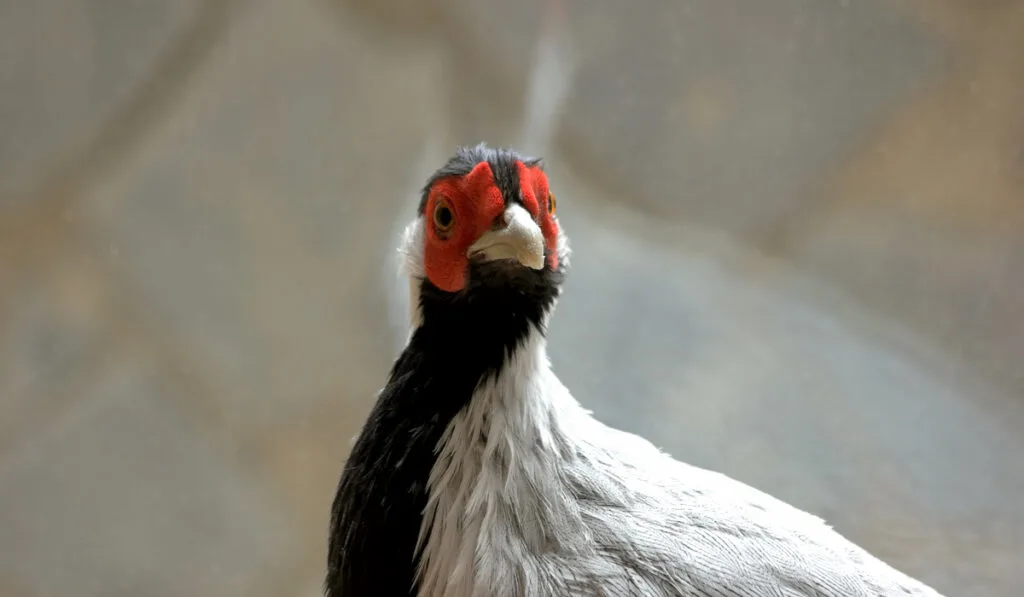
The Silver Pheasant is a common type of pheasant indigenous to Eastern China, Southern China, and Southeast Asia. You can also find these pheasants on the mainland in the United States and on the Hawaiian Islands.
Male Silver Pheasants are usually white with black barring, black belly, neck, and throats. Female Silver Pheasants, on the other hand, are brown with brownish-grey barring. Both males and females have red legs and bare red faces.
Like other pheasants, Silver Pheasants prefer to live in high-altitude forests. Their diet consists of plants, seeds, worms, and insects.
Bornean Peacock Pheasants
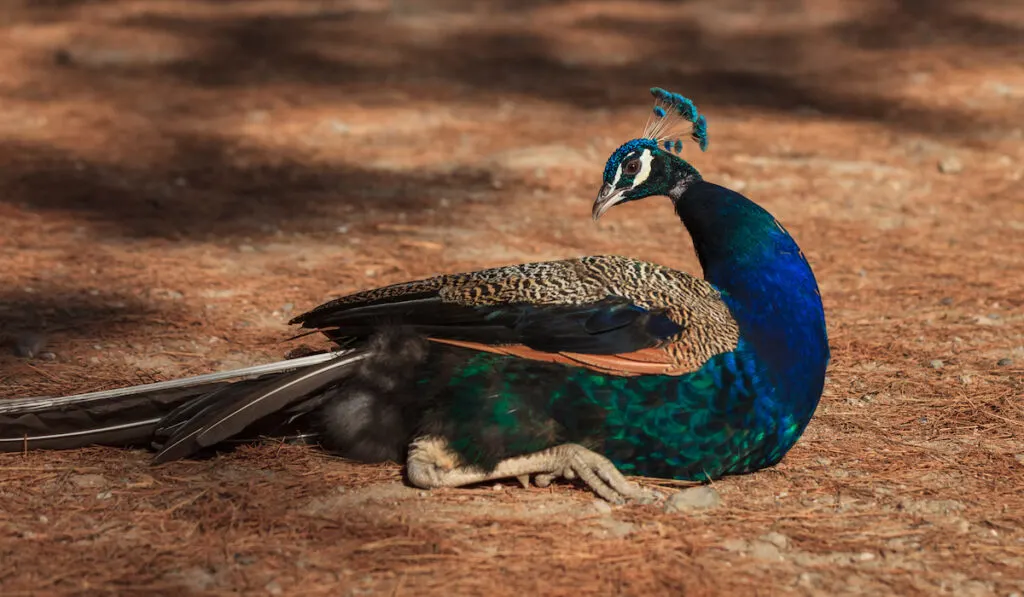
The Bornean Peacock Pheasant is a rare peacock pheasant that is indigenous to the lowland forest of Borneo. Bornean Peacock Pheasants are shy birds, and they prefer to quietly walk on the forest floor or roost in trees during the day.
Bornean Peacock Pheasants are medium-sized pheasants with females averaging 15 inches and the male averaging 17 inches in length.
Female Bornean Peacock Pheasants are smaller than the males, and the brown color of their plumage is relatively duller. They also have brown iris and no spurs on their feet.
Male Bornean Peacock Pheasants have metallic green eyespots on their tails and wings and two spurs on their feet. They also have metallic blue-green crests, purplish-green breasts with a white breast patch & throat.
Both males and females have black legs and feet, dark green bills, and red bare facial skin.
Brown-Eared Pheasants

The Brown Eared Pheasant is indigenous to the mountainous forests of China. Brown-Eared Pheasants are large pheasants that usually measure up to 39 inches in length.
Brown-Eared Pheasants have beautiful, hair-like, ornamental, glossy-brown plumage. Their ear tufts and black crowns are creamy white, and their legs and bare facial skin are crimson red.
The most notable feature of the Brown-Eared Pheasant is its white cheek tufts starting from the base of their bills, similar to an upturned mustache. Their tail feathers are broad with black edges, and when held high, they form a lovely arch. Then their rump is light cream in color.
Both male and female Brown-Eared Pheasants are almost identical, with the only difference between them being size. Female Brown-Eared Pheasants are generally smaller than males.
However, the spurs are used to determine the sex of this pheasant species. Those on male Brown-Eared pheasants are round at the base, while those of the females are oval.
The diet of the Brown-Eared Pheasants consists mainly of plant matter, roots, and bulbs.
Lady Amherst’s Pheasant

The Lady Amherst’s Pheasant is indigenous to northern Myanmar and southwestern China. It has a feather pattern similar to that of the Golden Pheasant, making it the second ruffled pheasant.
Male Lady Amherst’s Pheasants are pretty colorful. They have greenish backs, black & white tails, black & white neck ruffs, and red & yellow rumps. The females of this species are less showy and less colorful; they have a dull, mottled brown plumage.
Lady Amherst’s Pheasants inhabit dense, dark forests, making them tricky to spot.
Bulwer’s Pheasants
The Bulwer’s Pheasant, also known as the Bulwer’s Wattled Pheasant or Wattled Pheasant, is indigenous to Central Borneo’s tropical forests. They inhabit areas with elevations of up to 5,200 feet.
The Bulwer’s Pheasant is medium-sized, with females measuring an average of up to 20 inches. The males, on the other hand, average up to 31 inches in length.
Bulwer’s Pheasants are famous for their bright blue wattles that become longer during courtship. The males are seen as one of the most spectacular of all the pheasant species.
Male Bulwer’s Pheasants have dark blue to black plumage, purplish upper breasts, maroon chests, and purplish throats. They also have curved, white tail feathers, red legs, and two facial wattles that hide the side of their heads. They typically get their adult plumage when they are around two years old.
Female Bulwer’s Pheasants have an overall dull brown color with black patterns. They also have red legs, brown tails, blue facial skin, and have no crest.
The diet of a Bulwer’s Pheasant consists of insects, fruits, and worms.
Copper Pheasants
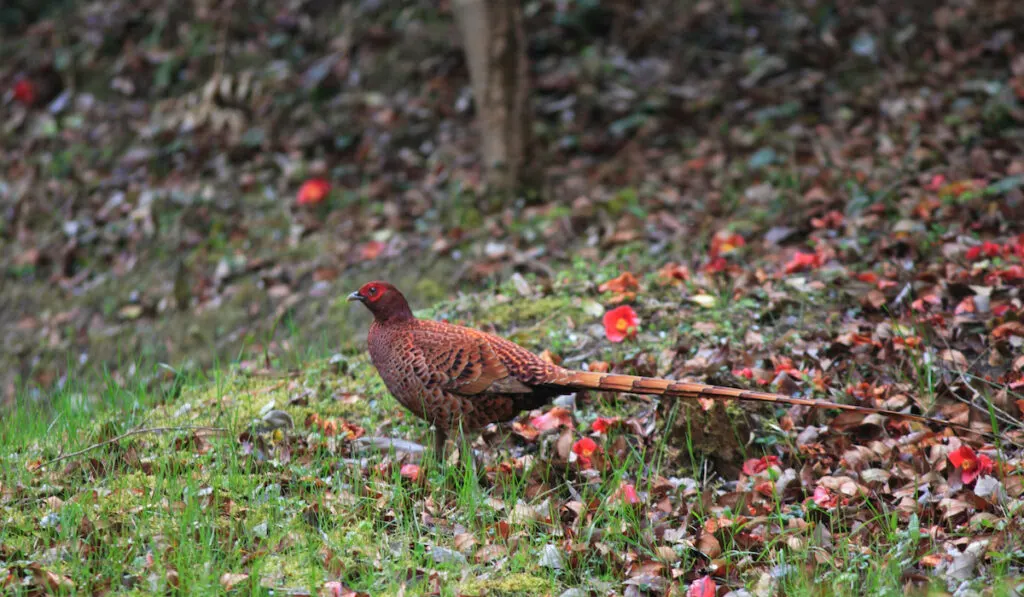
The Copper Pheasant is also known as the Soemmerring’s Pheasant. It is indigenous to the mountain forests and hills of the Shikoku, Honshu, and Kyushu islands of Japan.
Copper Pheasants are large pheasants that can measure an average of 53 inches in length. Male Copper Pheasants have beautiful copper-colored chestnut plumage. They also have red facial skin, yellow bills, and brown iris.
Only the males of this species have spurs on their legs.
Female Copper Pheasants usually have brown plumage with a buff dark-brown lower section and a grayish-brown upper section. The diet of the Copper Pheasant consists mainly of grains, insects, leaves, roots, and arthropods.
Cheer Pheasants
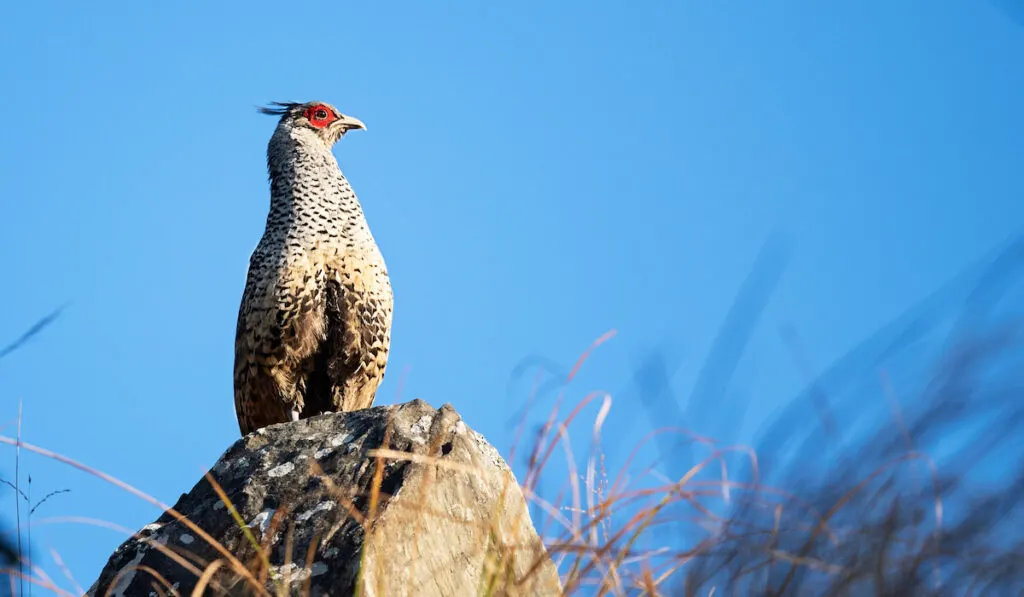
The Cheer Pheasant is another rare pheasant species found in the scrublands and highlands of the western Himalayas. Their range stretches from northern Pakistan through Kashmir into India, Central Nepal, Eastern Nepal, Uttar Pradesh, and Himachal Pradesh.
Cheer Pheasants prefer to inhabit steep and craggy hillsides with secondary growth and scrubs at elevations reaching 9,000 feet.
Unlike other pheasants, Cheer Pheasants are not brightly colored. Both males and females of this species have similar plumage: brown or grey with a buff bar tail. They also have red facial skin and long crests.
Male Cheer Pheasants measure an average of 3.9 feet, while females measure around 2.3 feet in length.
While female Cheer Pheasants have black breast feathers with white contours, males have white feathers with black, curved outlines. The markings on the males are more defined than those of the females.
Argus Pheasants
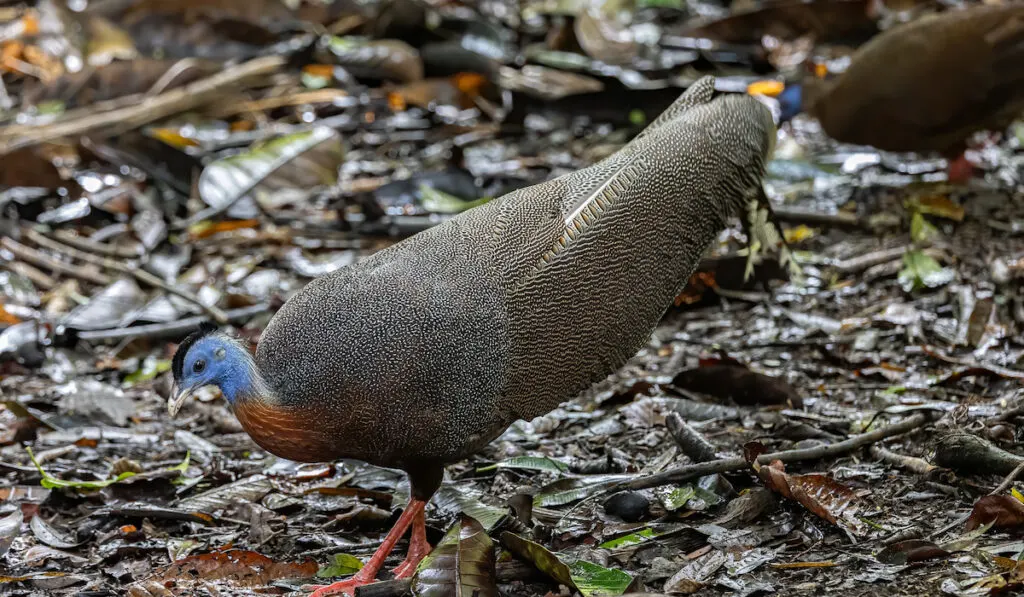
The Argus Pheasant is a close relative of the peacock. It is indigenous to Southeast Asia and occurs naturally in Borneo, Malay Peninsula, and Sumatra. Argus Pheasants prefer to inhabit forest areas from sea level to around 4000 feet.
Argus Pheasants have long tail feathers with an ornate eye-like design on the ends of their tail feathers. And the males can reach lengths of up to 3 feet.
Argus Pheasants prefer to associate only with their immediate family. They do not socialize outside family except when they perform mating rituals. The ideal diet of an Argus Pheasant consists of raw peanuts, greens, mealworms, and turkey pallets.
Crested Argus Pheasants
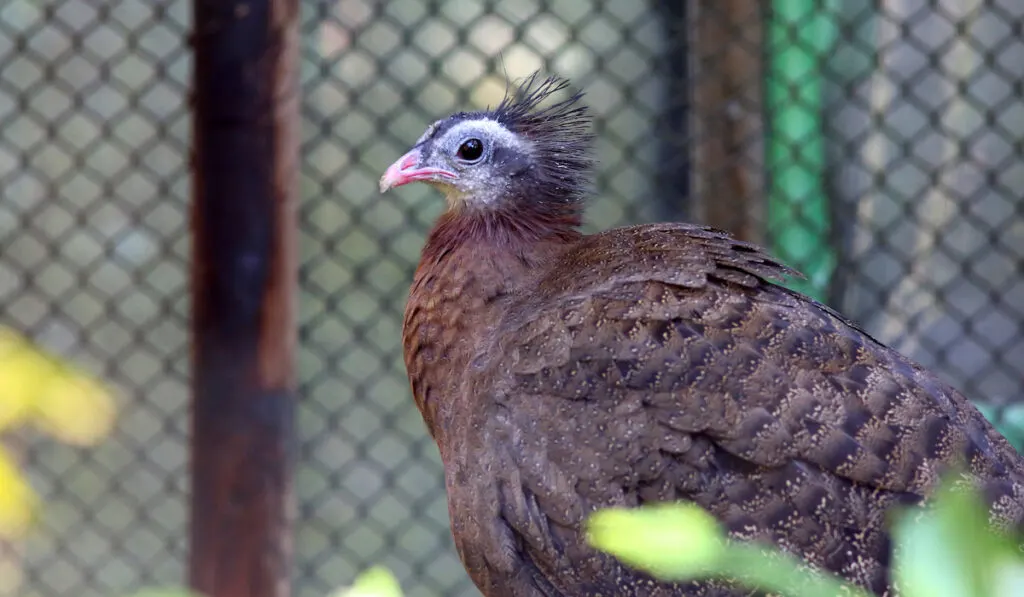
The Crested Argus pheasant is an elusive bird indigenous to Lao PDR, Malaysia, and Vietnam. Crested Argus Pheasant inhabits tropical forests.
Crested Argus Pheasants are large pheasants, and they can measure up to 7.5 feet in length. Male Crested Argus Pheasants have a dark brown plumage with black spots, blue skin around the eye, brown iris, and pink bills. Their small heads are decorated with white crest feathers.
Male Crested Argus Pheasants get their adult plumage when they are 3 years old. They typically have a broad, long tail, which reaches full length when they are 6 years old.
Female Crested Argus Pheasants are smaller and have shorter tails. Their plumage is darker with fewer spots, unlike the males. Their heads are also crested, with a distinctive pattern.
Although Crested Argus Pheasants are large birds, they are difficult to spot due to their shyness.
Hume’s Pheasant
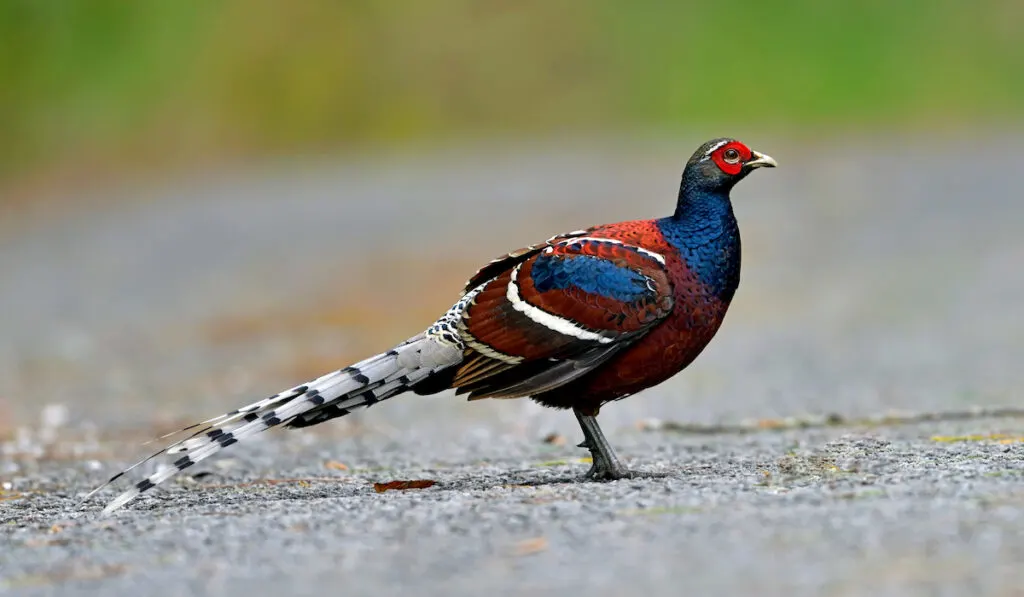
Hume’s Pheasant is also known as the Bar-Tailed Pheasant or Mrs. Hume’s Pheasant. It is indigenous to Northeastern India, Northern Burma, China, Thailand, and Myanmar. Hume’s Pheasants prefer to inhabit forest mountain areas with elevations ranging from 4,000 – 10,000 feet.
Hume’s Pheasants are large pheasants measuring an average of 2.9 feet in length. The males have chestnut-brown plumage, a greyish brown head, yellow bills, and red facial skin. Their wings have white bars, and they have blue metallic neck feathers and brownish-orange iris.
Male Hume’s Pheasants also have long tails that are greyish white barred with brown or black.
Female Hume’s Pheasants have chestnut-brown plumage with a white-tipped tail, white throat, and buff color belly.
The diet of Hume’s Pheasant consists mainly of vegetation matter.
Edward’s Pheasants

The Edwards’s Pheasant is indigenous to Central Vietnam’s bamboo forests. It is an endangered type of pheasant, with just over 3000 birds currently in the wild.
There are two existing races of Edwards’s Pheasants: L. e. edwardsi and L. e. hatinhensis.
The edwardsi race is the nominate form, and it comes with an upper tail and a white crest. The hatinhensis, which is the northern form, comes with several white tail feathers. The difference between the species is a result of inbreeding.
The Edwards’s Pheasant measures an average of 2 to 2.3 feet in length. It generally has red facial skin and red legs. The females have brown plumage while males have blue-black plumage with a crest.
The diet of the Edwards’s Pheasant consists of live food, game bird pellets, greens, and seeds.
Resources
- https://www.beautyofbirds.com/edwardspheasants.html
- https://petkeen.com/types-of-pheasants/
- https://www.beautyofbirds.com/elliotspheasants.html
- https://www.beautyofbirds.com/blueearedpheasants.html
- https://jualayamhias.com/types-of-pheasants/
- https://www.beautyofbirds.com/reevespheasants.html
- https://www.beautyofbirds.com/blueearedpheasants.html
- https://www.beautyofbirds.com/vieillotscrestedfirebacks.html
- https://www.beautyofbirds.com/temminckstragopans.html
- https://www.beautyofbirds.com/borneanpeacockpheasants.html
- https://www.beautyofbirds.com/himalayanmonalpheasants.html
- https://www.beautyofbirds.com/crestedarguspheasants.html
- https://www.beautyofbirds.com/brownearedpheasants.html
- https://www.beautyofbirds.com/bulwerpheasants.html
- https://www.beautyofbirds.com/copperpheasants.html
- https://www.beautyofbirds.com/cheerpheasants.html
- https://www.beautyofbirds.com/arguspheasants.html
- https://www.britannica.com/animal/argus-pheasant
- https://www.beautyofbirds.com/humespheasants.html
